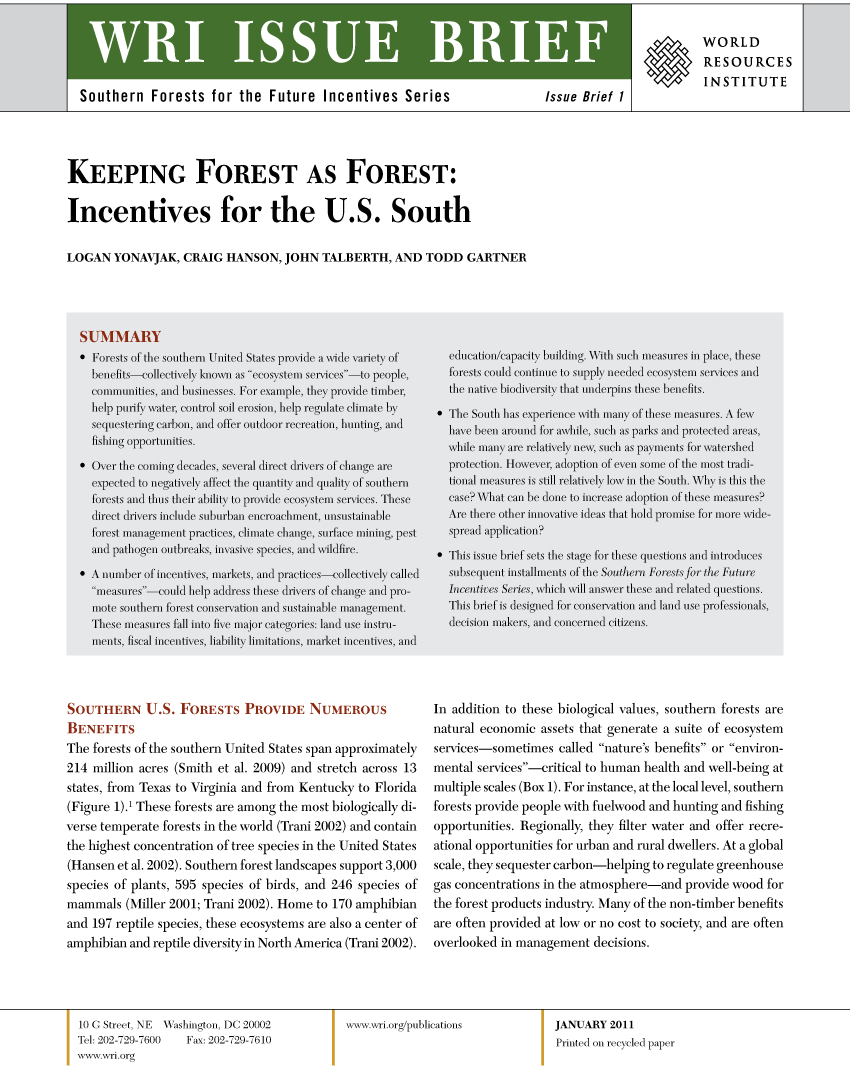Forests for Carbon: Exploring Forest Carbon Offsets in the U.S. South
 This issue brief explores forest carbon offsets in the context of the southern United States. It is intended as an introductory resource for southern woodland owners, nongovernmental organizations active in the region, offset project developers, and other forest carbon offset market stakeholders.
This issue brief explores forest carbon offsets in the context of the southern United States. It is intended as an introductory resource for southern woodland owners, nongovernmental organizations active in the region, offset project developers, and other forest carbon offset market stakeholders.
Downloads:
Full Text (PDF, 20 pages, 858kb)
Summary:
- Southern U.S. forests remove carbon dioxide from the atmosphere and store it in the form of carbon in leaves, roots, branches, trunks, soil, and woody debris and other plant litter through a process known as “carbon sequestration.” Through this process, southern forests and other woodlands play a role in regulating Earth’s climate and moderating the effects of global climate change.
- Emerging voluntary and compliance markets often have provisions for greenhouse gas emission reductions or emissions avoided by preventing forest conversion or changing forest management practices. These reductions or avoided emissions are considered “forest carbon emission reductions.”
- A “forest carbon offset” is a metric ton of carbon dioxide equivalent (CO2e), the emission of which is avoided or newly sequestered and is purchased by greenhouse gas emitters as a cost-control mechanism to compensate for emissions occurring elsewhere. Four types of forest carbon offset projects exist—reforestation, afforestation, forest conservation/avoided conversion, and improved forest management.
- Forest carbon offsets can create an incentive for southern woodland owners to engage in land management practices that retain or restore forests and bolster forest carbon sequestration capacity.
- Forest carbon offset projects must meet a number of quality criteria if they are to become credible, eligible for markets, and financially feasible for southern woodland owners. The main quality criteria include: assurance that the offset is real (including handling the issue of negative leakage), additionality/surplus, verifiability, permanence, and enforcement.
- Recently, a number of carbon offset standards have emerged that adhere to these quality criteria. These standards provide a detailed list of offset project eligibility requirements, or “protocols,” as well as methods for quantifying and verifying a project’s net emissions impact. These standards seek to provide consistency in determining offset eligibility and quantification, improve offset credibility, and lower transaction costs for offset providers.
- At present, from the financial standpoint of many southern woodland owners, income from forest carbon offsets alone is likely insufficient to outcompete real estate development. However, depending on landowner management goals and circumstances, income from forest carbon offsets might be sufficient in some instances to help pay incremental costs of sustaining forests, such as property taxes or sustainable forest management certification.
- Forest carbon offset markets, like all other markets, require robust demand, adequate supply, and good transactional infrastructure. In light of these three conditions, southern woodland owners can take several initial steps to explore and prepare for existing and upcoming markets: (1) monitor market demand for forest carbon offsets, (2) conduct a solid forest inventory to assess the potential to supply forest carbon offsets, (3) engage in project development, and (4) enroll in a credible offset registry.

